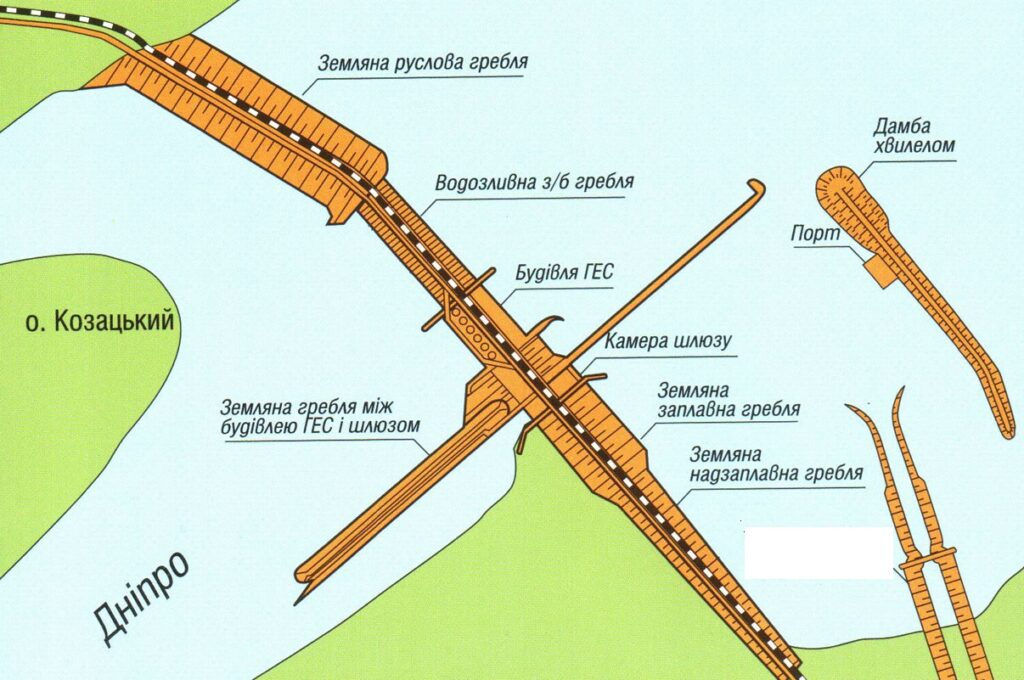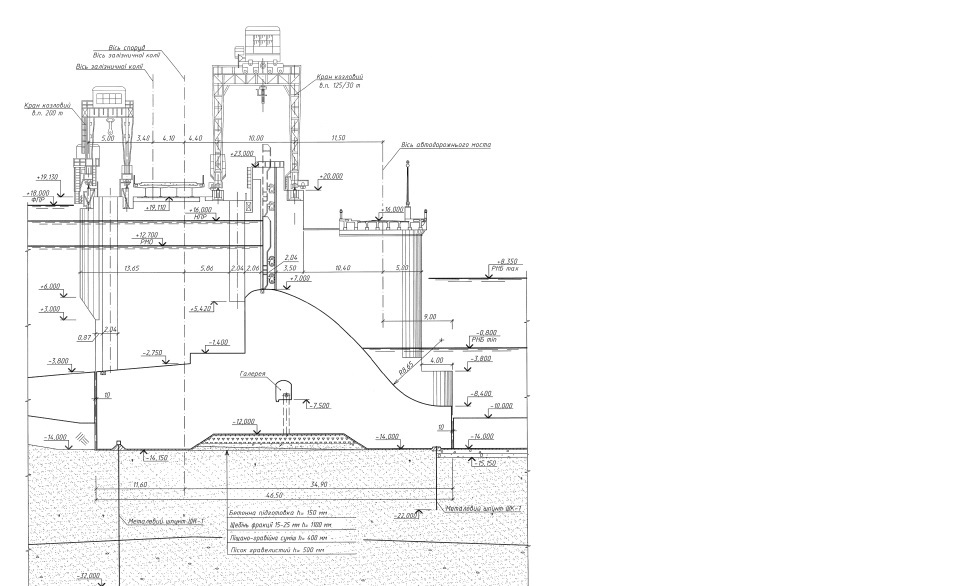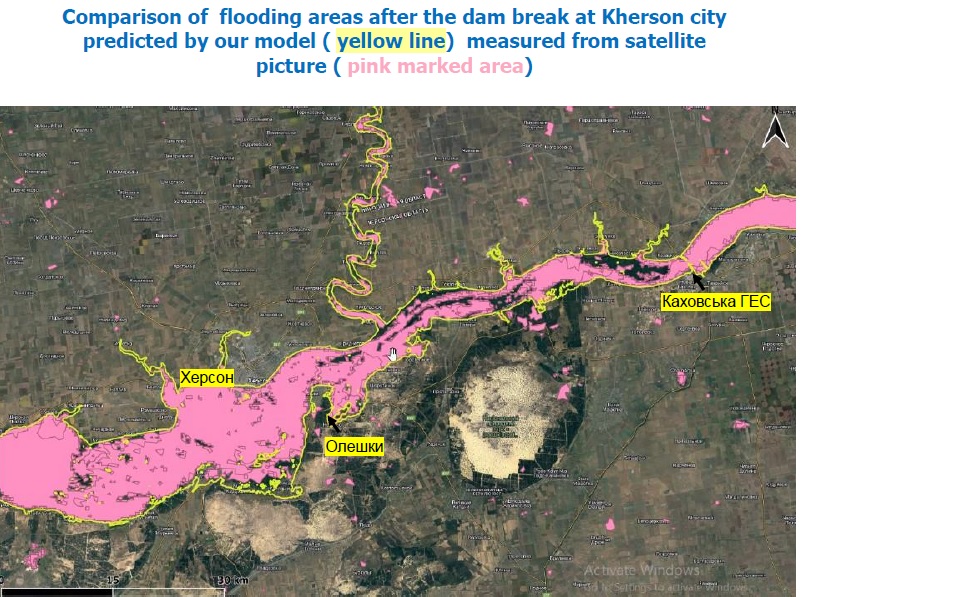The statements of the military and military-political leadership of Ukraine and the company “Ukrhydroenergo” that the Russian occupiers blew up the Kakhovs`ka HPP on June 6, 2023, received irrefutable scientific confirmation thanks to the calculations of a group of Ukrainian scientists.
“To blow up the dam – what happened in Kakhovka – you need to drop at least three air bombs weighing half a ton in one place. This cannot be done with the strikes of a single missile. It was a very powerful explosion in three places of the station. During the dismantling of our station, we will see it, the examination will prove it,” said General Director of Ukrhydroenergo Ihor Syrota on the air of the national TV in the first days after the Russian terrorist attack.
But there is currently no access to the destroyed dam. Does this mean that there is not enough evidence that the Russians were involved in the disaster?
The simulation result and measurement data dispel the Russian fake about the destruction of the dam by Ukrainian shelling. Such an instantaneous destruction of the entire main part of the dam, which is confirmed by the mathematical model, is possible only with explosives laid along the foundation of the entire length of the HPP dam,” says Professor Zheleznyak.
As soon as it became known about the breach of the dam, the Russians launched disinformation that the cause was shelling from Ukraine. They implored that due to the impact on the railway tracks and the automobile overpass, which are mounted in the upper part of the dam, the strength of the entire structure decreasedand it gradually collapsed under the pressure of the water.
But this simply could not happen. Such large-scale and rapid destruction could have been caused only by the undermining of the dam from the inside, but not by missiles hits with the subsequent gradual destruction of the structure.
In order to understand what happened to the Kakhovs’ka HPP, it is important to know exactly how the structure of the dam and what parts it consists of. If you move from the right bank to the left, it will look like this: an earthen river dam; spillway dam (has 28 spillway holes); the HPP building with an assembly platform (it has four sections: the first section is an assembly platform, three sections contain two hydraulic units each); an earthen dam between the lock and the HPP; shipping lock; earth flood dam. The total length of these structures is almost four kilometers (3850 m). Railway and road bridges are mounted on the upper part of the dam.
The spillway dam and the HPP building are constructed of reinforced concrete and rest on a massive reinforced concrete foundation. The height of the foundation is 21 meters, 14 of which are below the bottom level. The width at the base is 40 meters. Ukrainian experts claim that the Kakhovs’ka HPP was designed and built with such calculations to withstand a nuclear strike becomes clear.
But this colossal structure has its own “Achilles heel”. This is a service gallery that runs through the core of the foundation. And if you plant explosives there, it will cause a powerful and instantaneous destruction of the dam.

On June 6, seismic sensors (one in Romania and one in Ukraine) recorded signs of powerful explosions in the Kakhovs`ka Dam area. One at 2:35, the second at 2:54 a.m. According to Ben Dando, a seismologist at Norsar (Norwegian organization that specializes in seismology and seismic monitoring), both signals corresponded to an explosion, not, say, the collapse of the dam itself.
The fact of simultaneous destruction of a large fragment of the dam was confirmed by the calculations of Ukrainian scientists. These are specialists of the Institute of Problems of Mathematical Machines and Systems (IPMMS) and the Ukrainian Hydrometeorological Institute. And also a well-known specialist in mathematical modeling, Professor Mark Zheleznyak, presently of the Institute of Environmental Radiology of Fukushima University.

“The system of mathematical models for calculating the dynamics of radionuclides migration – one-dimensional, two-dimensional, three-dimensional – was created in the IPMMS since 1986. Each of these modeling complexes had primarily to calculate current fields and water surface dynamics in order to calculate how the water current transports river sediments. And then — how it transports radionuclides in a solution and with silt. The COASTOX two-dimensional modeling system was used in the late 1980s to substantiate the need for the construction of a water protection dam on the Pripyat floodplain near the Chernobyl nuclear power plant and to forecast contamination of the Dnipro reservoirs, and over the years, in the course of its development, it has become a world-class modeling complex for calculating hydraulic processes in rivers and the coastal zone sea. COASTOX analogs are MIKE 21 computer codes; TELEMAC; Delft3D, developed by the world’s leading companies in this field,” says Professor Zheleznyak.
The key contribution to the development of the modern parallel version of the model was made together with Mark Zheleznyak by the employees of the IPPMS department he managed until 2015 — Serhiy Kivva, Maksym Sorokin, Pavlo Kolomiets, Yevhen Yevdin.
“I also want to especially note the important contribution to the development of the COASTOX system software by Oleksandr Pilypenko, who worked at IPMMS after graduating from the physics department of Kyiv National University named after Taras Shevchenko. From February 24, 2022, Oleksandr voluntarily mobilized in the ranks of the Armed Forces of Ukraine,” said Mark Zhelezniak.
Since 2004, the model has been used every spring in the hydroforecasting department of the Ukrainian Hydrometeorological Center for operational calculations of flooding in the riverside areas of Kyiv.
In November 2022, when it became known that Russian troops had mined the Kakhovs`ka HPP dam, a group of Ukrainian scientists used combined maps of the depths of the Kakhovs`ka Reservoir, the lower Dnipro, the Dnipro-Bug estuary, the Black Sea, and maps of the topography of the banks of the lower Dnipro to model the consequences of the destruction of the Kakhovs`ka HPP, which may be flooded due to the destruction of the dam. Instantaneous formation of a 400-meter breach was accepted as the maximum scenario of dam failure.
“Forecast calculations – flood maps in the event of dam failure were submitted to the State Emergency Service in February 2023 in the form of digital maps of possible flood zones. Unfortunately, the dam was destroyed on 06/06/2023 and we got to see that these prognostic maps predicted the consequences of the disaster with great accuracy. We predicted the maximum water level near the water measuring station (wms) in Kherson to be 5.4 m high. Measurements after the explosion showed 5.6 m. From the morning of June 6, 2024, we carried out operational calculations with the transfer of the results to the State Emergency Service in comparison with the data of measurements below the dam (“Kherson” wms) and in the Kakhovs`ka reservoir (“Nikopol” wms). This comparison made it possible, firstly, to identify the dynamics of the breach: the immediate destruction of the dam by 400 meters, and from the second day onward – a gradual increase in the area of the breach due to erosion of the bottom. Secondly, to calculate the dynamics of flooding levels below the dam and the dynamics of drainage of the reservoir. A comparison of the simulation results of the maximum inundation zone with the satellite image processed by Andrii Oreshchenko also demonstrated the coincidence of the calculated inundation area with real inundation.

The simulation result and measurement data dispel the Russian fake about the destruction of the dam by Ukrainian shelling. Such an instantaneous destruction of the entire main part of the dam, which is confirmed by the mathematical model, is possible only with explosives laid along the foundation of the entire length of the HPP dam,” says Professor Zheleznyak.
Russia’s war against Ukraine continues. And the question arises: what next terrorist act will russia carry out tomorrow? Will blow up another HPP? Will it destroy the nuclear plant? Will it happen again in Ukraine or in another country in Europe or the world? Russia must be stopped as soon as possible. Every day of the war increases the destruction of the environment, so an important condition for reducing this damage is stopping russian aggression. The best way to stop the destruction of the environment now is to help Ukraine with weapons, ammunition, powerful sanctions against Russia
Oleg Lystopad, correspondent of the newspaper “Svit”
the full text of the article in Ukrainian is here
On the slides of Professor Zheleznyak:
The diagram of the Kakhovs’ka HPP dam in section
Comparison of the flooded areas in the forecast and in reality (space photo) after the Russian terrorist attack. Yellow lines are forecast, pink color is data from space
NB: The section of the waterway from Kakhovska HPP to Kherson is part of the so-called international waterway E40 (Gdansk-Kherson) as part of this route. A study by the experts of the “Save Polissia” project even before the full-scale invasion also showed the enormous value of biodiversity in this part of the E40 route and emphasized that this biodiversity could suffer if the E40 is implemented.
Of course, the impact of undermining the dam is an order of magnitude or two more negative than the potential consequences of building the E40, but analyzing the situation after the Russian sabotage helps to better understand the potential risks of the E40 as well.
***
Read also on the newspaper “Svit” website :
The undermining of the Kakhovs`ka HPP is a catastrophe of a planetary scale (interview with the director of the Institute of Hydrobiology of the National Academy of Sciences, Serhiy Afanasyev regarding the consequences of the terrorist attack for the environment)
What’s in the Black sea: the consequences of the Russians undermining the Kakhovs`ka HPP
Restoration of “Kahovka”: first of all – research (the view of the problem of the head of the department of ecological hydrology and technical hydrobiology of the Institute of Hydrobiology of the National Academy of Sciences, Serhii Dubnyak)
What will be the fate of the «Kakhovka Sea”? (an article by Academician Yakov Didukh about the results of the first expedition of botanists and ecologists to the area of the disaster in July 2023)
How to level the consequences of the terrorist attack on the Kakhovs`ka HPP? — scientific research is needed (comments of members of the Working Group of the National Academy of Sciences of Ukraine on the analysis of the consequences of the destruction of the Kakhovs`ka HPP dam to Yakov Didukh’s article,
What will grow at the bottom of the ‘Kakhovka Sea”
Will we see sturgeon near Kakhovka? (analytical article by Oleg Lystopad on the possibility of restoring the sturgeon stock after the terrorist attack on the HPP)
Yakiv DIDUKH: “Scientists should be involved in the assessment of environmental damage from Russian aggression” (about the results of the second expedition of botanists and ecologists to the area of the disaster in October 2023)
The Russian terrorist attack on the Kakhovs`ka HPP: environmentalists of the world are horrified by the consequences (about the “Kakhovs`ka” panel at the United for Justices. United for Nature international conference, which took place on October 20-21, 2023 in Kyiv with the participation of the ministers of environmental protection of many countries of the world and representatives of European institutions ).
Will we do without the ‘Kakhovka Sea’? (feasibility and possibility of restoration of the Kakhovka Reservoir from the point of view of hydrologists)
